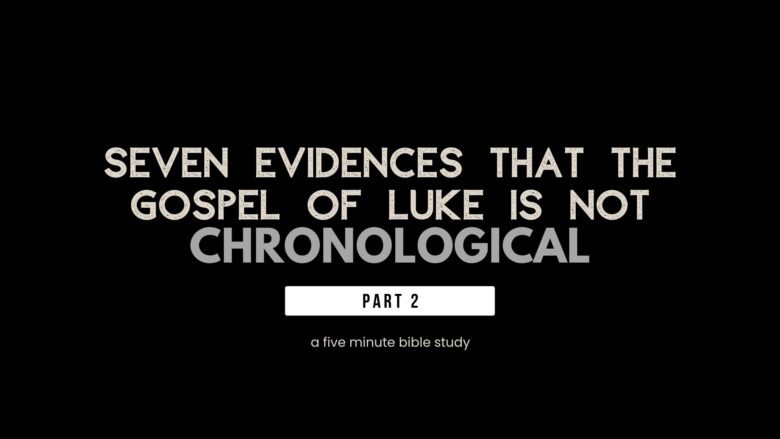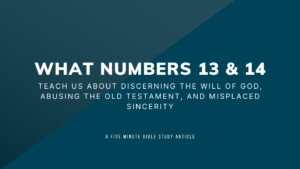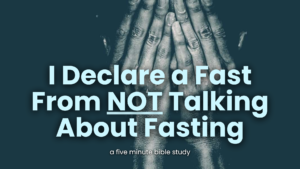In Part 1, “Bible Books of History Are Not Necessarily Chronological,” I looked at evidence from various books of history from the Old Testament to prove the title of that article. As we work our way to Luke 22:17-20, it’s important to establish that Luke is not strictly chronological leading up to the feature text. If it can be established that Luke does not prioritize chronology necessarily, then there is good reason to believe that Luke 22:17-20 is not a chronological retelling of events. In this article, we examine seven specific pieces of evidence from Luke’s gospel. Here they are.
Seven Evidences that the Gospel of Luke is Not Chronological
1. The Temptations of Jesus
(Luke 4:1-13 vs. Matthew 4:1-11)
| Matthew | Luke |
| Turn Stones Into Bread (4:3-4) | Turn Stones Into Bread (4:3-4) |
| Jump Off the Temple (4:5-7) | Worship Satan (4:5-8) |
| Worship Satan (4:8-10) | Jump Off the Temple (4:9-12) |
It is generally agreed that Matthew stays truer to chronology than does Luke. The likeliest explanation to the different order of the temptations of Jesus between these two gospel accounts is that Luke arranged the temptations thematically while Matthew arranged them chronologically.
2. Herod’s Imprisonment of John
(Luke 3:18-20)
|
Matthew |
Luke |
|
John Baptizes Jesus (3:13) |
John Imprisoned (3:18-20) |
|
John Imprisoned (14:3) |
John Baptizes Jesus (3:21) |
John’s imprisonment is brought up prematurely by Luke in 3:18-20. John is imprisoned in Luke 3:20, but he is out of prison and baptizing Jesus as soon as the next verse. In Matthew’s gospel, Jesus is baptized by John in 3:13, but Herod’s imprisonment of John does not occur till much after the baptism in 14:3. Is there a contradiction between Luke and Matthew? No. Luke’s comment about Herod’s imprisonment of John in 3:18-20 is not placed chronologically in the gospel. This is not a problem unless one binds a strict chronological sequencing on the gospel.
3. Sermon on the Mount
(Luke 6:20-49 v. Matthew 5-7)
| Matthew | Luke |
| Sermon on the Mount (Ch. 5-7) | Jesus Heals Paralytic (5:17-26) |
| Jesus Heals Paralytic (9:1-8) | Jesus Heals on Sabbath (6:1-11) |
| Jesus Heals on Sabbath (12:1-14) | Sermon on the Mount (6:20-49) |
The reason for the difference in order of the temptations of Jesus in Matthew and Luke’s gospels is the same explanation for the differing order of the sermon on the mount in these two gospels. It is most likely that Matthew recorded the sermon as it occurred in Jesus’ ministry chronologically while Luke abandoned chronology for some thematic or other literary motivation.
4. Jesus’ Nazareth Sermon
(Luke 4:16-30)
For Jesus’ Nazareth sermon to have occurred at the beginning of Jesus’ ministry, the sermon would have had to take place before Matthew 4:13 where it says specifically that Jesus left Nazareth. However, there is nothing in Luke 4:16-30 which necessitates placing this sermon at the beginning of Jesus’ ministry as if Luke is giving a chronological sequencing of events. Furthermore, Jesus’ rejection and attempted murder does not fit within the receptive atmosphere of Jesus’ first year of ministry as is manifested in Matthew 4 and the surroundings of Luke 4. This alone is not foolproof evidence that Jesus’ Nazareth Sermon took place in more proximity to His 3rd year (The Year of Rejection), but paired with evidence for Luke’s lower priority on chronology, the conclusion leans heavier on the side of Luke 4:16-30 being inserted into Luke’s gospel out of sequenced for thematic emphasis (possibly to emphasize the taking of the gospel to Gentile nations as a hint toward the rejection of Israel).
5. Peter’s Denial of Jesus Predicted
(Luke—The Upper Room [22:31-34,39] vs. Matthew—Mt. of Olives [26:30-35])
How are we to interpret Luke’s seeming displacement of Jesus’ prediction of Peter’s denial on the eve of His arrest? Matthew has the prediction of Peter’s denial after the upper room and on the Mt. of Olives, while Luke has the prediction in the upper room while eating the supper. With the other evidence already presented, and with there already being a question of chronology having arisen in the very same chapter regarding the cup in the Lord’s supper (22:14-23), it seems best to interpret the displacement of Peter’s denial in Luke’s account as just that—a displacement of chronological sequence. Luke intentionally displaced Jesus’ prediction of Peter’s denial in his gospel so that it reads thematically instead of chronologically. It could be that there is a literary structure in Luke 22 that creates a parallel between the prediction of Peter’s denial with the actual denial of Peter in Luke 22:54-62, or it could be that Luke placed Peter’s denial where it is so that it reads directly after the disciples’ proud dispute about who would be the greatest in the kingdom (22:24-30). These are at least very plausible explanations that place the burden of proof on the person proposing a chronological sequencing of Luke 22 or a textual discrepancy in Luke 22.
6. Beelzebub, Unclean Spirits & Jonah
(Luke 11:14-32 vs. Matthew 12:22-42)
| Matthew | Luke |
| Beelzebub (12:22-30) | Beelzebub (11:14-23) |
| The Sign of Jonah (12:38-42) | Unclean Spirits (11:24-26) |
| Unclean Spirits (12:43-45) | The Sign of Jonah (11:29-32) |
Beelzebub
Assuming that Luke arranges these accounts thematically, it would appear very plausible that Luke arranges the Parable of the Unclean Spirits directly after the charges about Jesus being in league with the devil in order to show that Jesus’ accusers are, in fact, the ones in league with the devil (unclean spirits).
Sign of Jonah
This may simply be an interesting observation, but even within the speech about the Sign of Jonah, Luke has Jesus saying that the Queen of the South will rise up in judgment and then the Ninevites rising up in judgment, while Matthew has Jesus naming the Ninevites first and then the Queen of the South.
| Matthew 12:39-42 | Luke 11:29-32 |
| Sign of Jonah | Sign of Jonah |
| The Ninevites & Jonah | Queen of South |
| Queen of South | The Ninevites & Jonah |
The structure in Luke 11:29-32 is of particular interest as it flows in a Jonah—Queen of South—Jonah arrangement. The structure in Luke 22:17-22 follows the same arrangement: cup—bread—cup. Perhaps this observation from 11:29-32 is helpful in interpreting Luke 22:17-22 later one. Are there two Jonah’s or one? Are there two cups or one?
7. Identification of Betrayer
| Matthew | Mark | Luke |
| Betrayer (26:21-25) | Betrayer (14:18-21) | Lord’s Supper (22:17-20) |
| Lord’s Supper (26:26-29) | Lord’s Supper (14:22-25) | Betrayer (22:21-23) |
It appears very obvious here that Luke departs from chronology in reporting this narrative as Matthew and Mark are both in harmony regarding sequence. With Jesus’ discussion of His betrayer and the prediction of Peter’s denial both being in Luke 22 as proofs of non-chronological arrangement in Luke’s gospel, this seems to strongly support the position for the two cups in Luke 22 being, in fact, one cup repeated twice for thematic emphasis.
Conclusion
One or two isolated evidences might be a fluke, but seven pieces of evidence that Luke does not prioritize chronology in his retelling of the gospel of Jesus holds some level of merit. In the next and final article, we will focus squarely on Luke 22:17-20 and draw some conclusions about the nature of Jesus reference to two cups in Luke’s gospel. Did Jesus take two separate cups or did He just take one?



